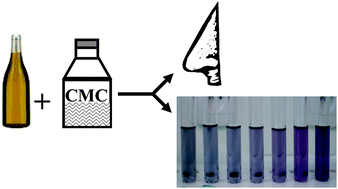Following the resolution Oeno 2-2008 of the OIV, “Organisation Internationale de la Vigne et du Vin”, the addition of carboxymethyl cellulose (CMC) in wines at a concentration lower than 100 mg L−1 is authorized in the EU (RCE 606-2009). In order to control this level, a method has been elaborated to quantify CMC addition at the maximum limit authorized. It is based on the absorbance level of a coloured complex obtained by the addition of a solution of 2,7-dihydronaphthalene in concentrated sulfuric acid to a dry white wine that has been dialyzed; the proposed method has a quantification limit of 60 mg L−1 with a 40 mg L−1 uncertainty. Despite these relatively high values, the method is, nevertheless, suitable for its purpose. Some wines, elaborated and CMC supplemented, allowed one to test the CMC quantification method, in real conditions of wine production. All the measurements provide a CMC quantification at the expected level, within the uncertainty. These samples, sets of treated and untreated wines, were submitted to sensory evaluation to assess the impact of CMC addition to wine. At the maximum authorized level, no significant difference was detected by the 20 expert panel under quality control requirements. Moreover, some experiments, performed to determine the concentration threshold at which the CMC effect is noticeable, showed that even at a level 15 times higher than the maximum amount authorized, CMC has no impact on the taste or the nose of the wines.


 Please wait while we load your content...
Please wait while we load your content...